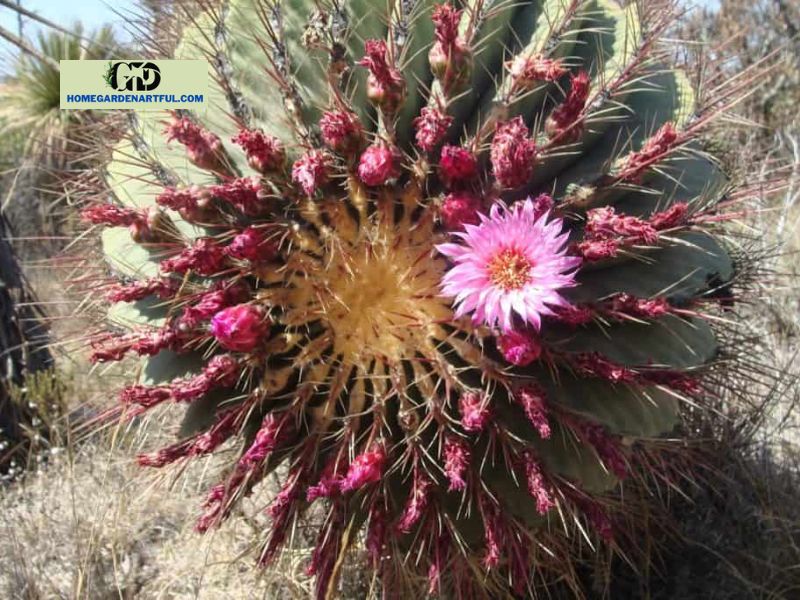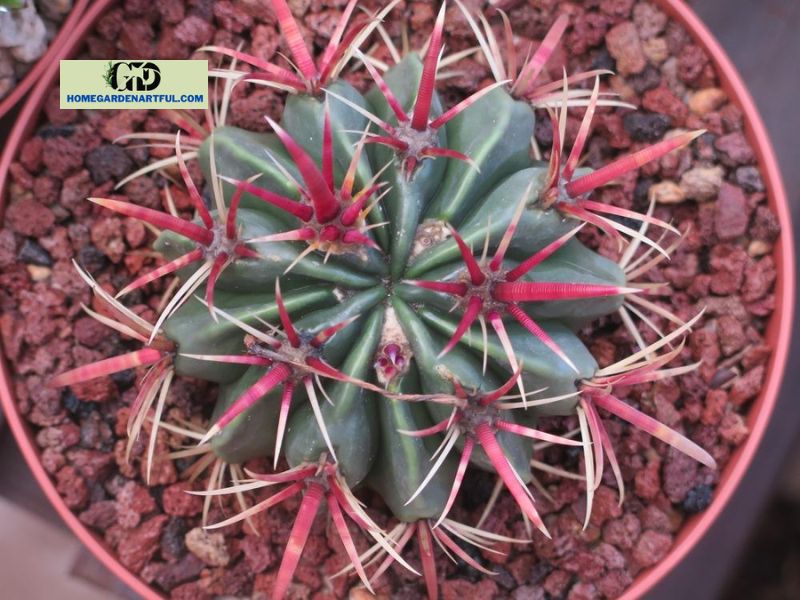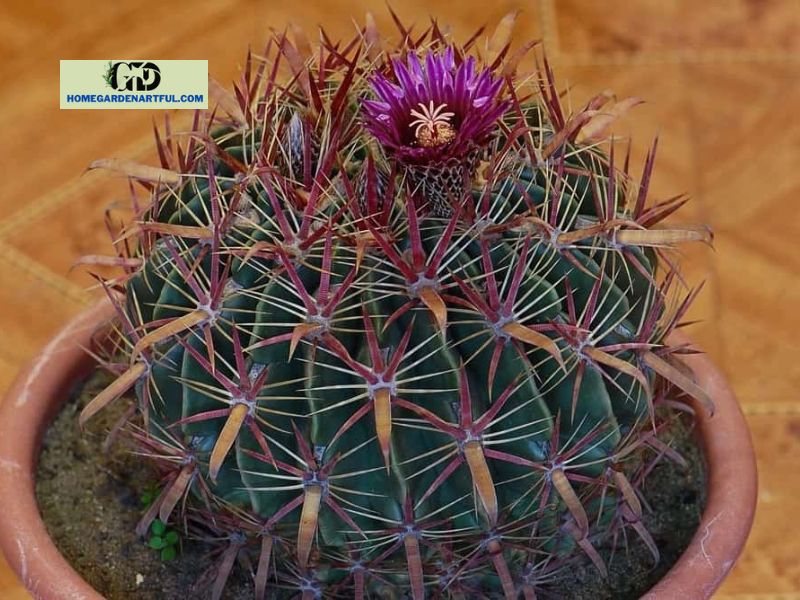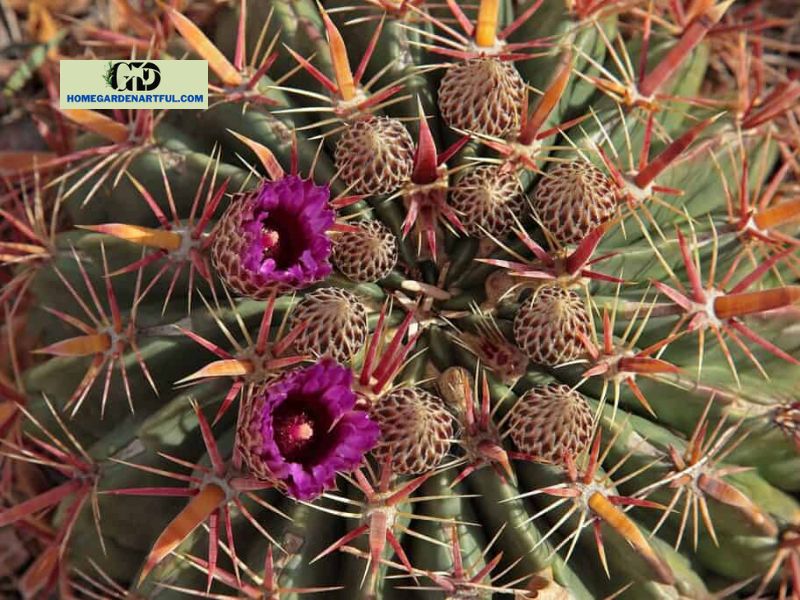Devil’s Tongue Cactus (Ferocactus latispinus) is another cactus plant that merits a place in your home. Its globular body is separated by 21 acute ribs, which distinguishes it from other cacti. Then it’s covered with bright red thorns that protrude like pointed tongues. Its one-of-a-kind appearance makes it quite the eye-catcher. Discover at homegardenartful.com!
Devil’s Tongue Cactus Care

The care and maintenance needs for Devil’s tongue cactus are relatively simple. This plant is not picky. If you’re new to gardening, this cactus species is a fantastic place to start. Even more so if you are a cactus fan. So, first and foremost, here are the unique growing requirements:
Light
Before you decide to cultivate Ferocactus latispinus, make sure you have sufficient sunlight. This plant prefers direct sunlight and will very definitely require it for the most of its life. It’s better to put this outside where it will get enough sunlight throughout the day.
If you intend to keep it indoors, there are few techniques to meet the Ferocactus latispinus light requirements. First, choose a spot with plenty of light, such as a patio or a window. Second, place more light sources around your plant. This supplement is especially beneficial when the outside light is dim.
Watering
Watering is not necessary for the devil’s tongue barrel cactus. The plant is a cactus, and they are classified as CAM plants. They have a unique system for producing their own food while preserving moisture. They only open their stomata at night, rather than throughout the day. They won’t lose as much water this way.
Watering Ferocactus latispinus can thus be done seldom. They can withstand drought conditions without succumbing to stress. As a result, it is advisable to use the soak-and-dry approach as a watering technique.
Temperature
It is vital to remember that the plant enjoys a warm environment when it comes to Ferocactus latispinus temperature requirements. This type of environment promotes the growth and development of your cactus. The optimal temperature should be 10oC (50oF) or above. USDA hardiness zones 9b through 11b provide a favorable climate.
This plant can also withstand freezing up to 0oC (32oF). But only for a brief period of time. Prolonged and repeated icing exposure could harm the look of Ferocactus latispinus, resulting in brown lesions. It may also result in the death of your favourite cactus.
Air Humidity
The humidity requirements of Ferocactus latispinus are simple and undemanding. Low to moderate humidity levels will be adequate to satisfy the plant. Just keep in mind that it prefers to stay warm and dry all of the time. Otherwise, the additional moisture will harm your budding cactus. That is something we do not want to happen.
As a rule of thumb, keep it in the lowest humidity region possible. Kitchens and baths are strictly forbidden! As a result, try to avoid them at all costs. Keep it away from groupings of tropical plants, as they enjoy excessive humidity.
Soil
Remember two things when preparing the Ferocactus latispinus soil. It must be lightweight and well-draining. We want a combination that is well-aerated and contains enough spores to allow water to drain quickly. As a result, they don’t stay in the pot as long, lowering the chance of root rot.
The pH of the soil should be acidic to neutral. Before planting your cactus, always sanitize the soil. The right potting soil is an important part of caring for Ferocactus latispinus. As a result, it is critical that you take this seriously.
Fertilizing
When it comes to cactus, there isn’t much need for extra nutrition. They are not voracious feeders and can usually live on low-nutrient soils. In general, fertilizing is unnecessary, particularly if the plant is healthy.
However, if you want to give it a small boost, do so during its active period. These times are in the spring and summer. Utilize a fertilizer with a high nitrogen concentration. Reduce the concentration by diluting it. Otherwise, your plant could suffer from fertilizer burns. An overabundance of fertilizer can easily harm a plant. As a result, it’s advisable to only apply fertilizer when it’s really necessary.
Propagation

Ferocactus latispinus propagation is similar to that of other cacti species. Allow the offsets to grow to a significant size before removing them from the mother plant. Remove the offsets gradually, leaving some behind, particularly the younger ones.
Plant each offset in a separate pot. It should be nurtured until it develops its own root system. The tiny cactus will soon be able to stand on its own. Ferocactus latispinus seeds can also be used to propagate the plant. The decision is entirely up to you. Remember that the devil’s tongue grows slowly, so be prepared to wait with additional patience.
Re-Potting
Ferocactus latispinus is often re-potted every other year. It prefers to be pot-bound for a while because its roots are shallow. Unless the plant develops root rot, the need to transfer to a new container will be infrequent.
When the time comes to report, simply choose a container that is an inch larger than the old one. Make a new batch of well-draining potting soil. Take the cactus out of its old planter. Trim the roots and put them in their new home. Water the soil until it is completely soaked. Place it in a partially shady area initially until it hardens.
Pruning

Pruning Ferocactus latispinus is not usually necessary. You can leave it alone because it lacks leaves and branches. However, as the base begins to generate offsets, you may need to eliminate a few from time to time. The plant’s base will be less crowded as a result. You should also get rid of the unhealthy parts right away.
To generate clean incisions when trimming the offsets, consistently employ a sharp and disinfected knife. Remove the part with a single cut. Clean wounds would aid in the prevention of pathogen infection. As a result, the cut section can callus and heal in a short period of time.
FAQ
How should a devil’s tongue cactus be cared for?
To ensure that your barrel cactus grows and thrives, provide full sun, light, and free-draining soil, as well as very little water.
How large can a devil’s tongue cactus grow?
This barrel cactus can reach a height of 30 cm (12 in) and a width of 40 cm (16 in). They form thick columns in the shape of a barrel.
How is the devil’s tongue cactus propagated?
Separation of offsets is the best approach to grow a devil’s tongue cactus. You can separate and sow these new babies.


